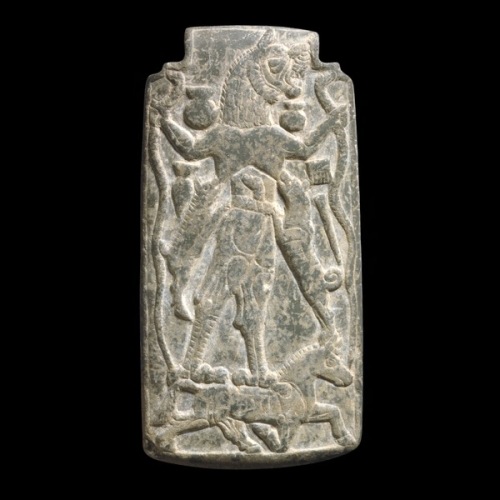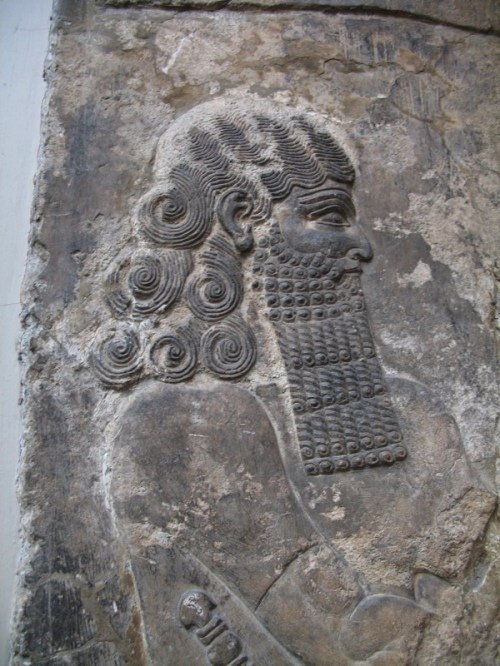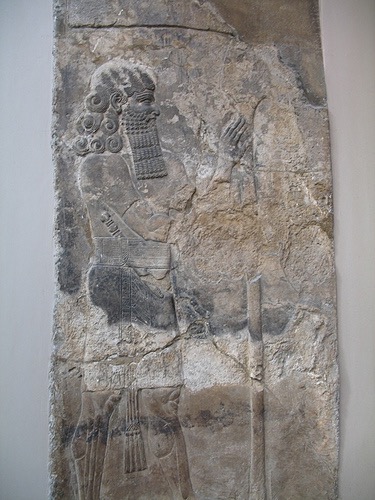Lahmu, “The Hairy One,” is Not Apkallu
“The Babylonian scientific and religious texts reveal the names of over three thousand gods and demons, members of local and national pantheons. Most, if not all, play a part in cult or magic, and must have been represented in some form.
Gods and demons, cult and magic, are the main subjects of Babylonian art, but generally texts and art cannot be combined. Captions and parallelism between text and representations on boundary stones and other monuments allowed the identification of a number of divine symbols; the Lamaštu ritual texts matching the Lamaštu amulets allowed the identification of the demons Lamaštu and Pazuzu, and of objects playing a part in the ritual.

Amulet with a figure of Lamashtu
From Mesopotamia, around 800 BC
A demonic divinity who preys on mothers and children
This is a protective image of Lamashtu, a fearsome female divinity of the underworld, intended to keep evil at bay. Although she is usually described in modern works as a demon, the writing of her name in cuneiform suggests that in Babylonia and Assyria she was regarded as a kind of goddess. Unlike the majority of demons, who acted only on the commands of the gods, Lamashtu practised evil apparently for its own sake and on her own initiative. There is a cuneiform incantation on the reverse to frighten her away.
Lamashtu’s principal victims were unborn and new-born babies. Slipping into the house of a pregnant woman, she tries to touch the woman’s stomach seven times to kill the unborn baby, or she kidnaps the child. Magical measures against Lamashtu included wearing a bronze head of Pazuzu. Some of these plaques show a bedridden man rather than a pregnant woman, so they seem to relate to Lamashtu as a bringer of disease.
Lamashtu is described in texts as having the head of a lion, the teeth of a donkey, naked breasts, a hairy body, stained hands, long fingers and finger nails, and the talons of a bird. Plaques also show her suckling a piglet and a whelp while she holds snakes in her hands. She stands on her sacred animal, the donkey, which is sometimes shown in a boat, riding through the underworld.
H.W.F. Saggs, Babylonians (London, The British Museum Press, 1995)
J. Black and A. Green, Gods, demons and symbols (London, The British Museum Press, 1992)
http://www.britishmuseum.org/explore/highlights/highlight_objects/me/a/amulet_with_figure_of_lamashtu.aspx
(The Lamaštu amulets have been collected by Walter Farber, “Lamaštu,” Reallexikon der Assyriologie (RlA) 6/V-VI, 1983, p. 441; see also his discussion in E. Rochberg-Halton ed., Language, Literature, and History, Fs E. Reiner, 1987, p. 85ff), and Walter Farber, Lamaštu: An Edition of the Canonical Series of Lamaštu Incantations and Rituals and Related Texts from the Second and First Millennia BC, Eisenbrauns, 2014.)
Two texts, the “Göttertypentext” and the “Unterweltsvision,” describe the visual appearance of a number of supernatural beings, but both are atypical and can be used only with extreme caution. More promising was a group of texts containing descriptions of prophylactic figures, gods and demons, but efforts to combine the described figures with the actually excavated ones were hampered by the fragmentary state of preservation of K 2987B+ (below text I) and bīt mēseri (below text III).
(E. Köcher, “Der Babylonische Göttertypentext,” Mitteilungen des Instituts für Orientforschung (MIO), vol. 1, 1953, p. 57ff.; Wolfram von Soden, “Die Unterweltsvision eines assyrischen Kronprinzen,” ZA 43 (1936) 1ff. See also K. Frank, MAOG 14/2, 1941, p. 23ff. (discussions of figures), and the new edition of Alasdair Livingstone in State Archives of Assyria (SSA) Vol. III, Helsinki, 1989, pp. 68-76.)
Thus texts and art remained largely seperated. Philology retired and the explanation of Mesopotamian art was left to archaeologists and art historians. The conviction gained ground that this state of affairs was necessary rather than accidental: there was indeed but a loose connection between the imaginary world of the texts and that of the objects.
Scribes and artists expressed different theologies on the basis of a less specified common culture. Observations by the famous German assyriologist B. Landsberger supported this theory. Landsberger adduced arguments to indentify the naked hero and the bull man, two traditional figures of art, with the apkallu, “sage,” and the GUD.DUMU.dUTU, the “Bull-Son-of-the-Sun.”

Lahmu is an Akkadian deity, the mythological first-born son of Apsu and Tiamat. With his sister Lahamu, they were the parents of Anshar and Kishar, the father of the sky and the mother of the earth, who begat the first gods. Lahmu is depicted as a snake, or as a bearded man with six hair curls. For the Sumerians, Lahmu was “the muddy one,” and this title was ever after given to the gatekeeper of the Abzu temple of Enki at Eridu. As gatekeeper, he is termed Lahmu the Hairy, or sometimes “the Hairy One.”
http://en.wikipedia.org/wiki/Lahmu
Landsberger’s identifications and conclusions, however, cannot be upheld. His identification of the naked hero as apkallu was based on a sign miscopied by E. Eberling and a fragmentary duplicate from London. Collation and new duplicates revealed the true name of the naked hero: lahmu, “the hairy one” (JEOL 27 p.91). History and connotation of “lahmu” perfectly match the history of the naked hero, and there is no longer any reason to suspect separate origins.
Landsberger’s equation GUD.DUMU.dUTU = bull man was based on etymology and the justified expectation that the bull man under some name occurs in the texts. The equation could be proved only now (below VII.C. 6), and it is evident that GUD.DUMU.d UTU is a logographic spelling of kusarikku, “bison,” a term well known throughout Babylonia in various other spellings. Again the history of “kusarikku” matches the history of the bull man, and again there is no reason to suspect separate origins.

Lahmu, “Hairy,” is a protective and beneficent deity, the first-born son of Apsu and Tiamat. He and his sister Laḫamu are the parents of Anshar and Kishar, the sky father and earth mother, who birthed the gods of the Mesopotamian Pantheon. Laḫmu is depicted as a bearded man with a red sash-usually with three strands- and four to six curls on his head. He is often associated with the Kusarikku or “Bull-Man.” In Sumerian times Laḫmu may have meant “the muddy one”. Lahmu guarded the gates of the Abzu temple of Enki at Eridu. He and his sister Laḫamu are primordial deities in the Babylonian Epic of Creation –Enuma Elis and Lahmu may be related to – or identical with- ‘Lahamu’ one of Tiamat’s Creatures in that epic.
http://foundfact.com/portfolio-view/lahmu/#!prettyPhoto
http://foundfact.com/library/beings-people-and-gods/page/6/#!prettyPhoto
(Since lahmu, “the hairy one,” names the naked hero (hero with six curls) after his visual appearance, art must have played a part in the early formation of the supernatural world. In the case of “(mythological) Bison,” the artistic expression (bull-man) is secondary.)
Since a separation of texts and art cannot be maintained in the case of these two most prominent figures (others could be added), the theory of independent origins and development loses its supporting argument. The observed gap between art and texts is accidental, not necessary.”
F.A.M. Wiggermann, Mesopotamian Protective Spirits: The Ritual Texts, STYX&PP Publications, Groningen, 1992, pp. xi-xii.

![Illustration: Shamash the Sun-god setting (?) on the horizon. In his right he holds a tree (?), and in his left a ... with a serrated edge. Above the horizon is a goddess who holds in her left hand an ear of corn. On the right is a god who seems to be setting free a bird from his right hand. Round him is a river with fish in it, and behind him is an attendant god; under his foot is a young bull. To the right of the goddess stand a hunting god, with a bow and lasso, and a lion. From the seal-cylinder of Adda ..., in the British Museum. About 2500 B.C. [No. 89,115.]](https://therealsamizdat.com/wp-content/uploads/2015/01/an00135126_001_l.jpg?w=500)